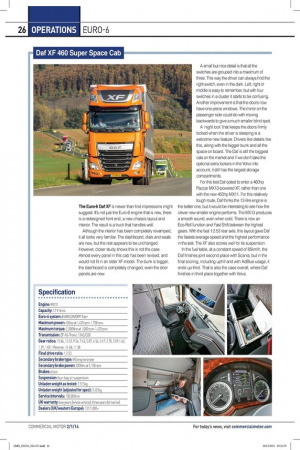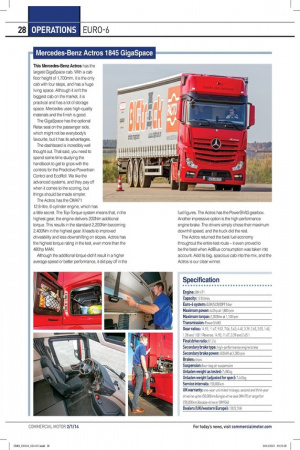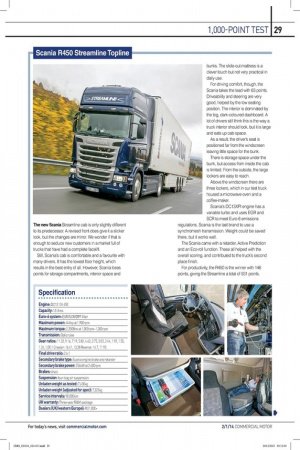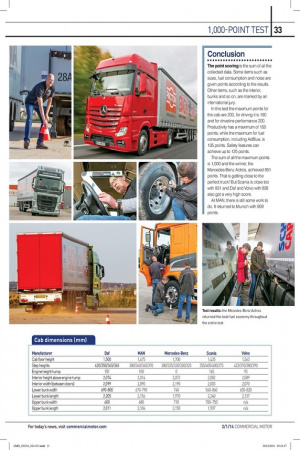Continental operators have embraced Euro-6, and here the European press
Page 20

Page 22

Page 23

Page 24

Page 25

Page 26

Page 27

Page 28

Page 29

If you've noticed an error in this article please click here to report it so we can fix it.
puts five of the latest 4x2 tractors through the 1,000-point test By lep van der Meer
Famous five
Daf XF 460 Super Space Cab
The Euro-6 Daf XF is newer than first impressions might suggest. It's not just the Euro-6 engine that is new, there is a redesigned front end, a new chassis layout and interior. The result is a truck that handles well.
Although the interior has been completely revamped, it all looks very familiar. The dashboard, dials and seats are new, but the rest appears to be unchanged. However, closer study shows this is not the case. Almost every panel in this cab has been revised, and would not fit in an older XF model. The bunk is bigger, the dashboard is completely changed, even the door panels are new.
A small but nice detail is that all the switches are grouped into a maximum of three. This way the driver can always find the right switch, even in the dark. Left, right or middle is easy to remember, but with four switches in a cluster it starts to be confusing. Another improvement is that the doors now have one-piece windows. The mirror on the passenger side could do with moving backwards to give a much smaller blind spot.
A 'night lock' that keeps the doors firmly locked when the driver is sleeping is a welcome new feature. Drivers like details like this, along with the bigger bunk and all the space on board. The Daf is still the biggest cab on the market and if we don't take the optional extra lockers in the Volvo into account, it still has the largest storage compartments. For this test Daf opted to enter a 460hp Paccar MX13-powered XF, rather than one with the new 450hp MX11. For this relatively tough route, Daf thinks the 13-litre engine is
the better one, but it would be interesting to see how the clever new smaller engine performs. The MX13 produces a smooth sound, even when cold. There is now an Eco-Roll function and Fast Shift between the highest gears. With the fast 1:2.53 rear axle, this layout gave Daf the fastest average speed and the highest performance in the test. The XF also scores well for its suspension.
In the fuel table, at a constant speed of 85km/h, the Daf finishes joint second place with Scania, but in the final scoring, including uphill and with AdBlue usage, it ends up third. That is also the case overall, where Daf finishes in third place together with Volvo.
MAN TGX XXL 18.480
The Euro-6 MAN TGX is easily identified by a new front layout with a huge air intake in the lower section. The interior is mainly the same and while the XXL cab, together with the Daf, has the biggest total volume, it has the least storage space of the five trucks tested. The interior could be improved by moving the fridge and taking out the console next to the seat. The external lockers are a good size, and feature big doors.
The driving position is good and while the dashboard looks Audi-esque with all the black and silver, the arrangement of switches could be improved, as could the side mirrors. The huge mirror housings have the dimensions of a bathroom cabinet and create a sizeable blind spot.
The MAN has the 12.4-litre D2676 6-cylinder common-rail engine, which tackles Euro-6 with a combination of EGR, SCR and a DPF. The ZF AS-Tronic, or as MAN calls it MAN TipMatic, communicates perfectly with the engine and scores maximum points.
MAN uses the fastest rear axle with a reduction of 1:2.61, and has the highest power output of all our test trucks. The maximum torque is 2,300Nm between 1,050rpm and 1,400rpm, resulting in the best driveline performance. The MAN EVB engine brake works well and the truck handled all downhill sections without any intervention from the drivers. MAN uses a clever compressor that is only driven when needed, and preferably when the engine is not working hard. That way the loss of fuel to feed the compressor is limited.
On the road, the MAN did not impress when it came to comfort, steering and gear changing. The ZF gearbox is close to perfect but the way the gearbox is operated from the centre console, along with the stalk on the steering column, could be improved. MAN was second best for suspension, after the Daf.
Overall, the MAN is a spacious, comfortable truck that scores highly for power, performance, space and suspension, but it loses points for fuel consumption and practical items in the cab. That results in last position for the lion from Munich.
Mercedes-Benz Actros 1845 GigaSpace
This Mercedes-Benz Actros has the largest GigaSpace cab. With a cab floor height of 1,700mm, it is the only cab with four steps, and has a huge living space. Although it isn't the biggest cab on the market, it is practical and has a lot of storage space. Mercedes uses high-quality materials and the finish is good.
The GigaSpace has the optional Relax seat on the passenger side, which might not be everybody's favourite, but it has its advantages.
The dashboard is incredibly well thought out. That said, you need to spend some time studying the handbook to get to grips with the controls for the Predictive Powertrain Control and EcoRoll. We like the advanced systems, and they pay off when it comes to the scoring, but things should be made simpler. The Actros has the 0M471 12.8-litre, 6-cylinder engine, which has
a little secret. The Top-Torque system means that, in the highest gear, the engine delivers 200Nm additional torque. This results in the standard 2,200Nm becoming 2,400Nm in the highest gear. It leads to improved driveability and less downshifting on slopes. Actros has the highest torque rating in the test, even more than the 480hp MAN. Although the additional torque didn't result in a higher average speed or better performance, it did pay off in the
fuel figures. The Actros has the PowerShift3 gearbox. Another impressive option is the high-performance engine brake. The drivers simply chose their maximum downhill speed, and the truck did the rest.
The Actros returned the best fuel economy throughout the entire test route — it even proved to be the best when AdBlue consumption was taken into account. Add its big, spacious cab into the mix, and the Actros is our clear winner.
Scania R450 Streamline Topline
The new Scania Streamline cab is only slightly different to its predecessor. A revised front does give it a slicker look, but the changes are minor. We wonder if that is enough to seduce new customers in a market full of trucks that have had a complete facelift. Still, Scania's cab is comfortable and a favourite with many drivers. It has the lowest floor height, which results in the best entry of all. However, Scania loses points for storage compartments, interior space and
bunks. The slide-out mattress is a clever touch but not very practical in daily use.
For driving comfort, though, the Scania takes the lead with 63 points. Driveability and steering are very good, helped by the low seating position. The interior is dominated by the big, dark-coloured dashboard. A lot of drivers still think this is the way a truck interior should look, but it is large and eats up cab space.
As a result, the driver's seat is positioned far from the windscreen leaving little space for the bunk.
There is storage space under the bunk, but access from inside the cab is limited. From the outside, the large lockers are easy to reach.
Above the windscreen there are three lockers, which in our test truck housed a microwave oven and a coffee-maker. Scania's DC13XPI engine has a variable turbo and uses EGR and SCR to meet Euro-6 emissions
regulations. Scania is the last brand to use a synchromesh transmission. Weight could be saved there, but it works well.
The Scania came with a retarder, Active Prediction and an Eco-roll function. These all helped with the overall scoring, and contributed to the truck's second place finish.
For productivity, the R450 is the winner with 146 points, giving the Streamline a total of 931 points.
Volvo FH 460 Globetrotter XL
The previous generation of Volvo FH never scored particularly well, but this new cab is a winner. It has the best access and the largest volume of storage space when the optional lockers against the rear cab wall are included. Although the FH is not the best when it comes to cab dimensions, it is well organised and has plenty of practical space. The interior scores highly: although the light colours work well, and the overall finish is great, there is still room for improvement. The sunroof would benefit from an electric blind, and
the I-Shift controls should be moved to the dashboard. That way the fridge could be positioned closer to the driver.
Even without the individual front suspension system, the FH is excellent to drive. For road behaviour/steering it shares first place with the Actros. But overall, the Volvo does not score very well, which is mainly down to the on-board electronics.
The driveline is managed by the I-See system, which did not do its job properly. We were surprised by the fuel figures and when the FH was returned to Gothenburg it was discovered there was a problem with the GPS data transfer to the I-See system. That meant the driveline got the wrong information and did not work as it was supposed to. At 85km/h, the Volvo uses 21.04 litres every 100km, putting it in fourth place. On full throttle, the Volvo takes last place, not helped by the faulty I-See system. AdBlue consumption was also very high.
Electronics rule these days, and Volvo proves that things can go wrong there.
The Volvo VEB+ engine brake is very powerful, but there is no way to set the downhill speed in the legal speed limit. At every downhill section, we had to adjust the settings, which is a pity, because the engine brake is powerful enough in itself.
We think Volvo's software department would benefit from a long trip with a truck driver to find out how its electronics work in the real world.
High-tech
Comparing trucks is no longer just about the nuts and bolts — high-tech is now the magic word. Three of the five trucks featured here have predictive systems that adjust speed and gears to the topography of the road, and four of the five have an Eco-roll system. The Actros also has the Top-Torque system that gives 200Nm more in the highest gear, while the Daf has Fast Shift between the highest gears. All those systems could make a comparison difficult, but we
decided to let the systems do their job. We wanted to test the complete truck, with everything the industry has to offer, so drove the 180kmlong test route with all systems engaged, allowing the speed to drop to 75km/h when rolling over the top of the hills. The speed setting on all the trucks was 85km/h, and we allowed them to go downhill at up to 90km/h.
This new driving style certainly takes getting used to, and when the intelligent systems decide to drop the speed to 75km/h, it seems very slow. Still, the journey times were not affected, which means the systems were doing their jobs.
The test
In this 1,000-point test we compare five Euro-6 tractor units with the biggest cabs available and a power output of about 460hp. We asked the truck manufacturers for 460hp, plus or minus 20hp, giving us a bandwidth between 440hp and 480hp.
All five trucks were driven on the test track by all five test drivers. After every lap, the trailers were swapped, which led to some interesting combinations.
During the test runs, data was collected via fuel meters and a stopwatch at almost every changeover point. This way any distortions by traffic conditions could be corrected when needed. It also gave us exact data about the driveline at every part of the test route.
Conclusion
The point scoring is the sum of all the collected data. Some items such as sizes, fuel consumption and noise are given points according to the results. Other items, such as the interior, bunks and so on, are marked by an international jury.
In this test the maximum points for the cab are 200, for driving it is 190 and for driveline performance 200. Productivity has a maximum of 150 points, while the maximum for fuel consumption, including AdBlue, is 135 points. Safety features can achieve up to 125 points.
The sum of all the maximum points is 1,000 and the winner, the Mercedes-Benz Actros, achieved 951 points. That is getting close to the perfect truck! But Scania is close too with 931 and Daf and Volvo with 928 also got a very high score.
At MAN, there is still some work to do. It returned to Munich with 909 points.












































